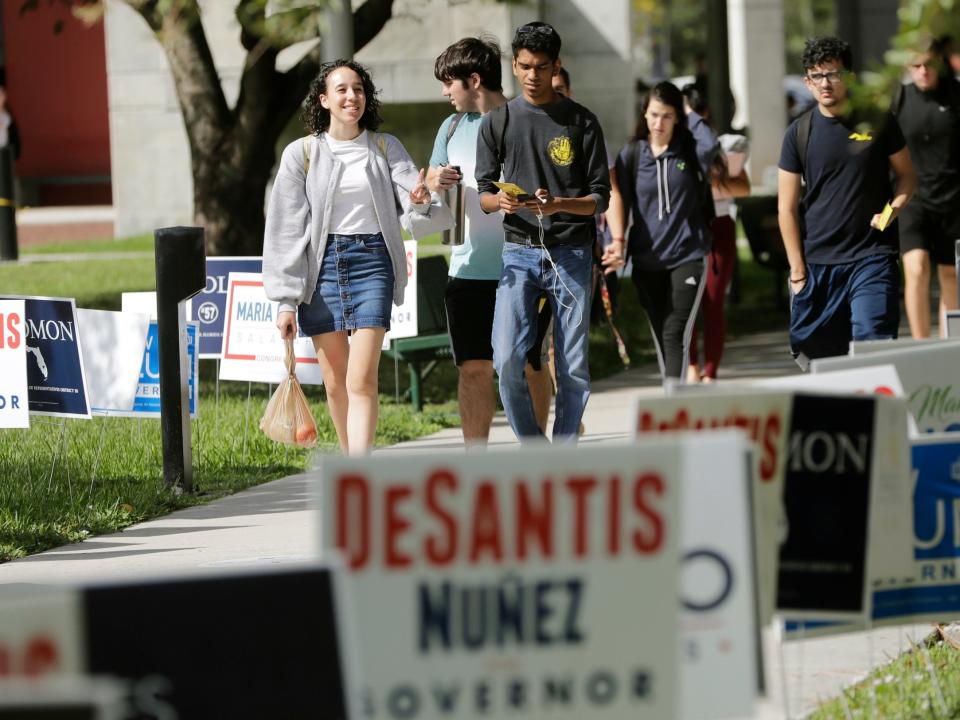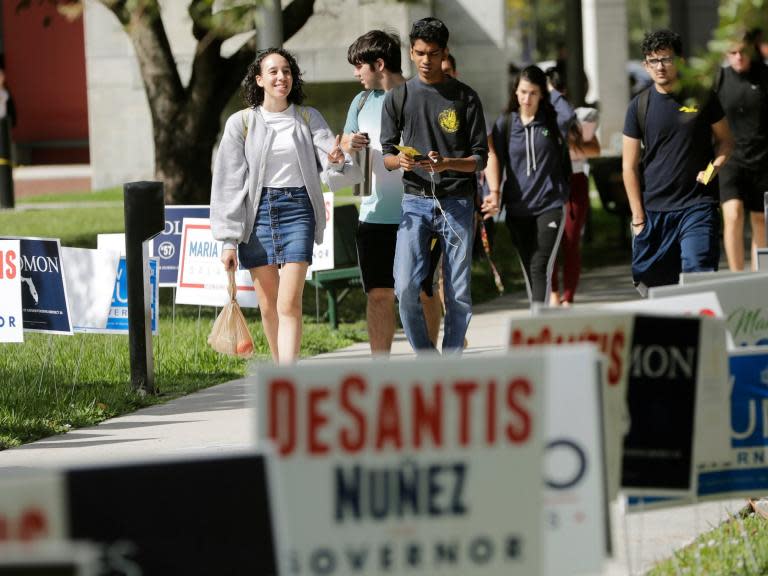Midterms 2018: On the campaign trail where one of the most expensive Senate elections in US history has made politics unavoidable
It is near impossible to avoid the 2018 midterm elections in southern Florida, where one of the most expensive Senate races in US history is coming down to the wire with both candidates in an all-out sprint to convince voters to send them to Washington.
Outside most polling places, virtually every inch of grass is packed full of wire signs with names voters will see up and down the ballot. Nearby, volunteers have been setting up shop beyond the required one hundred foot perimeter from the doors that lead to the polls to hand out pamphlets and urge voters to support ballot initiatives to end things like greyhound dog racing or to give voting rights back to felons who have completed their court sentences.
Flooding the airwaves are adverts featuring Governor Rick Scott and Senator Bill Nelson as they battle for the latter’s seat in Congress. Warnings and praise are also ubiquitous for gubernatorial candidates Ron DeSantis — a Republican and former US representative — and Andrew Gillum — the Democrat and current mayor of Tallahassee.
If you live live anywhere in the Miami metropolitan area, you would be hard pressed not to encounter a call to civic responsibility towering on billboards above your morning commute: Vote November 6.
Those adverts are a costly endeavour in Florida’s expensive media markets, and has made the Senate race one of the most expensive contest in history as the candidates try to negotiate through difficult political issues in the state from the devastation caused by Hurricane Michael, state expansion of Medicaid, and the concerns created by red tide algae blooms that have touched coastlines in both Republican and Democratic precincts this year.
That’s not to mention the long shadow that President Donald Trump has cast on the midterms.
“He’s a breath of fresh air. I like everything he’s been doing,” William Johnson, a boat vibration analyst from Fort Lauderdale, said when asked about the president. He voted for Mr Scott, he said, alongside other Republicans on the ballot.
Meanwhile: “I hate the son of a b****. I’ve hated him all my life,” said Brent Nichelin, a property manager in Fort Lauderdale who voted for Democratic candidates, said of the 45th president after voting. “He’s a professional liar. Not just pathological. Professional”.
All told, a record $181 million has been spent in the Florida Senate race, according to an analysis of Federal Election Commission reporting by the Centre for Responsive Politics. That includes over $91 million spent by the candidates themselves, and another $90 million spent by outside groups on the election. That figure is only rivalled by the spending in the Texas Senate race, where the battle between Republican Ted Cruz and Democrat Beto O'Rourke has racked up a $117 million tab.
That spending in Florida is fuelled in part by Mr Scott, who has spent nearly $40 million of his own money to support his campaign. All told, the Scott campaign has outspent the Nelson campaign $66 million to $25 million, according to CRP data.
The spending in Florida is coming close to the $188 million spent on the Pennsylvania Senate race in 2016 — which is widely seen as the most expensive such race in history.
The election has come to be seen, as many races in the 2018 midterms have, as something of a referendum on Mr Trump’s first two years in office. Mr Scott has appeared alongside the president at rallies in the state, praising him for his help after Michael made landfall in the Florida panhandle last month.
Mr Nelson, meanwhile, has aligned with the most recent Democratic administration — a frequent bogeyman of Mr Trump’s.
“We’re at an important inflection point right now,” Mr Nelson said at a recent rally in Orlando with former Vice President Joe Biden. “Now more than ever folks in Florida need somebody they can trust. They need public servants that know right from wrong.”
Heading into the final days of the campaign, the two have remained neck and neck in the polls with Mr Nelson — a third term senator — leading by just 1.4 points in averages compiled by Real Clear Politics. Mr Scott is currently the governor of Florida, and is term limited to that job.
Either way, voters understand why so much dough has been spent in the Sunshine State: The American political climate that elevated a contentious figure like Mr Trump to the White House has done anything but heal in the two years since November 2016.
“Right now, unfortunately, our country is divided, and I think people are only thinking Democrat or Republican,” Jeanette, a Republican voter and insurance professional who asked that her last name not be published, said.
Jeanette, referring to the president’s frequent attacks on the news media and the confusion that has been planted as a result, said that people are thinking in a non-existent binary — things are more complicated than pro-Trump or anti-Trump, she said.
“There is no black and white,” she said. “There’s a lot of grey”.


